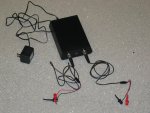Finally found time to assemble the complete unit - enclosure, connectors, professional PCB. Attached below are a few pictures and screenshots.
The scope is working like a treat - sample rate up to 1 MSample/sec, usable analog bandwidth up to approx. 200 kHz (limited by sample rate - the raw -3dB bandwidth is around 500 kHz). It has everything a "real" scope should have (with the exception of AC coupling) - range from 1V/div down to 20mV/div (20 divisions, i.e. twice as much as a "standard" display, so maximum range is 20V), offset control, different timebase settings, trigger on channel 1 or autotrigger, trigger level and polarity control, etc. Measurements are done with the cursors (also shown in the screenshot). With a single channel and short record (125 points) the screen update rate is close to 10 frames/sec, less with full record length (250 points) and dual channel, but still very usable.
The basic PC software is finished, although there is still some room for improvement - I am thinking of adding gain/offset calibration (will make the absolute level display more accurate), real-time FFT to show the signal's frequency spectrum, and setup save/restore.
The screenshot shows the scope in dual channel mode - channel 1 displays the 10 kHz trigger signal from my signal generator, channel 2 displays a damped sine wave produced by this generator (sine wave frequency is 100 kHz).
As to the hardware, the jumpers (red) allow to use either the MAX153 or the ADC0820 as the scope's ADC - the latter has a lower nominal sample rate (400 kS/sec, as opposed to > 1 MS/sec for the MAX153) but is second-sourced and seems to be easier/cheaper to acquire if you can't get them as a free sample. That said, I got a few ADC0820's from Maxim and was able to run them up to 1 MS/sec without any problems.
Wolfgang
The scope is working like a treat - sample rate up to 1 MSample/sec, usable analog bandwidth up to approx. 200 kHz (limited by sample rate - the raw -3dB bandwidth is around 500 kHz). It has everything a "real" scope should have (with the exception of AC coupling) - range from 1V/div down to 20mV/div (20 divisions, i.e. twice as much as a "standard" display, so maximum range is 20V), offset control, different timebase settings, trigger on channel 1 or autotrigger, trigger level and polarity control, etc. Measurements are done with the cursors (also shown in the screenshot). With a single channel and short record (125 points) the screen update rate is close to 10 frames/sec, less with full record length (250 points) and dual channel, but still very usable.
The basic PC software is finished, although there is still some room for improvement - I am thinking of adding gain/offset calibration (will make the absolute level display more accurate), real-time FFT to show the signal's frequency spectrum, and setup save/restore.
The screenshot shows the scope in dual channel mode - channel 1 displays the 10 kHz trigger signal from my signal generator, channel 2 displays a damped sine wave produced by this generator (sine wave frequency is 100 kHz).
As to the hardware, the jumpers (red) allow to use either the MAX153 or the ADC0820 as the scope's ADC - the latter has a lower nominal sample rate (400 kS/sec, as opposed to > 1 MS/sec for the MAX153) but is second-sourced and seems to be easier/cheaper to acquire if you can't get them as a free sample. That said, I got a few ADC0820's from Maxim and was able to run them up to 1 MS/sec without any problems.
Wolfgang
Attachments
-
131.5 KB Views: 325
-
163 KB Views: 434
Last edited:



